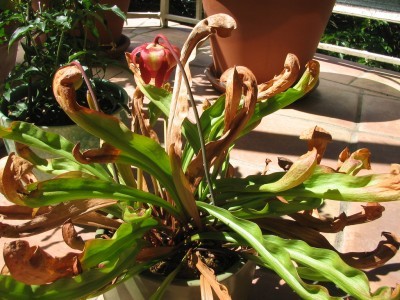






Adding a pitcher plant or three to your garden or interior space adds a touch of the unusual. Beyond being interesting carnivorous specimens, the pitcher plant produces a beautiful bloom as a reward to a gardener who has cared for it well. When your pitcher plant turns yellow or brown, it’s not time to panic; these hardy plants are hard to keep down for long.
More than likely, your pitcher plant is just getting older; browning or yellowing pitcher plants are perfectly normal even when plants have received excellent care. As individual pitchers age, they may start to yellow, then brown and collapse. If it’s only the oldest or largest pitchers doing this, it’s nothing to worry about; your plant is just shedding its oldest pitchers. As fall approaches, a normal plant will begin to go dormant and stop replacing the shed pitchers.
If you’re unsure about pitcher plant care and the pitcher plant turning brown or yellow is discolored all over, you may have bigger problems. Although pitcher plants are bog natives, they don’t tolerate standing water like their carnivorous contemporaries, immediately reduce watering to dry out the soil around the plant’s crown. If you’re watering with tap water, this could be causing problems as well. Many fanciers believe the heavy minerals in tap water can cause injury, so stick to purified or filtered water.
Pitcher plants that are changing color may be trying to tell you that something is wrong in their environment. This requires a total evaluation of the system where they live; these plants are not the same as your philodendrons or gerbera daisies and they have very unique needs. Your growing medium should be loose but absorbent, like the bogs from which these plants hail. A slightly acidic pH is also beneficial.
Try moving your plant into a sunny area; pitcher plants need full sun to do their best. However, if you place them in a window with bright, direct sunlight, they may burn, so choose your location carefully.
Humidity should be high, around 60 percent when possible. Moving your plant to a terrarium might improve its color. Remember that carnivorous plants thrive in poor soils and get most of their nutrition from consuming insects; fertilizer can be very damaging to these plants.
Nepenthes Pitcher Plants: Treating A Pitcher Plant With Red Leaves
Pitcher Plant Pest Control: Learn About Pests Of Pitcher Plants
Do Pitcher Plants Bloom: Learn About Pitcher Plant Flowers
Pitcher Plant Info: Growing Pitcher Plants In The Garden
Carnivorous Plant Problems: Why A Pitcher Plant Has No Pitchers
Rooting Pitcher Plants: Tips On Growing Pitcher Plants From Cuttings
Copyright © www.100flowers.win Botanic Garden All Rights Reserved